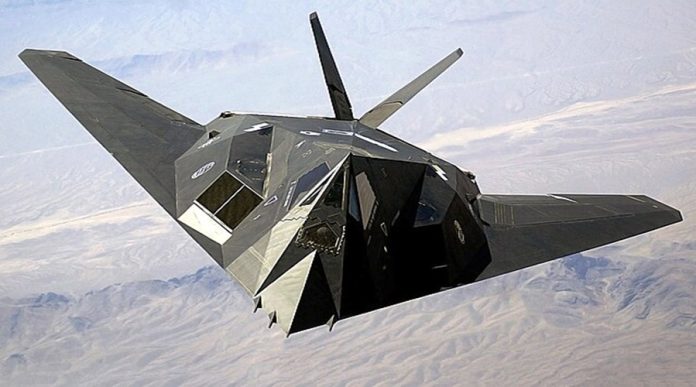Stealth fighter jets represent the pinnacle of modern military aviation, integrating advanced materials, aerodynamics, and electronic warfare capabilities to reduce their radar and infrared signatures. Below are the top 10 stealth fighter jets in the world, ranked based on their technology, combat effectiveness, and operational capabilities.
1. Lockheed Martin F-22 Raptor (USA)
The Lockheed Martin F-22 Raptor is a fifth-generation air superiority stealth fighter designed for unmatched dominance in aerial combat. Powered by twin Pratt & Whitney F119-PW-100 engines with thrust vectoring, it offers extreme maneuverability and supercruise capability at Mach 2.25. Its AN/APG-77 AESA radar provides superior situational awareness, while stealth technology minimizes radar cross-section (RCS). The F-22 carries AIM-120 AMRAAM and AIM-9X Sidewinder missiles in internal bays for reduced detectability. With integrated electronic warfare and sensor fusion, the F-22 excels in beyond-visual-range engagements, making it the most advanced operational fighter in the world.
2. Lockheed Martin F-35 Lightning II (USA)
The Lockheed Martin F-35 Lightning II is a state-of-the-art, multirole fifth-generation stealth fighter designed for air superiority, ground attack, and electronic warfare. Developed under the Joint Strike Fighter (JSF) program, it comes in three variants: F-35A (conventional takeoff), F-35B (short takeoff/vertical landing – STOVL), and F-35C (carrier-based operations). Equipped with an AN/APG-81 AESA radar, Distributed Aperture System (DAS) for 360-degree situational awareness, and sensor fusion capabilities, the F-35 provides unmatched battlefield connectivity. Its Pratt & Whitney F135 engine enables Mach 1.6 speed, while stealth coatings reduce radar detection, making it one of the most advanced fighters in service today.
3. Sukhoi Su-57 Felon (Russia)
The Sukhoi Su-57 Felon is Russia’s first fifth-generation stealth multirole fighter, designed to excel in air superiority and strike missions. Developed by Sukhoi for the Russian Air Force, it incorporates stealth technology, supercruise capability, and advanced avionics. The Su-57 is powered by twin Saturn AL-41F1 engines, with future upgrades expected to include the more powerful Izdeliye 30 engines for enhanced thrust and fuel efficiency. Equipped with the N036 Byelka AESA radar and L-band wing-mounted radars, it boasts superior detection capabilities. With internal weapons bays for reduced radar cross-section (RCS), the Su-57 is Russia’s answer to Western fifth-generation fighters like the F-22 and F-35.
4. Chengdu J-20 Mighty Dragon (China)
The Chengdu J-20 Mighty Dragon is China’s premier fifth-generation stealth fighter, developed by Chengdu Aerospace Corporation for the People’s Liberation Army Air Force (PLAAF). Designed for air superiority and deep-strike missions, it features stealth shaping, canard-delta wing configuration, and diverterless supersonic inlets (DSI) to minimize radar cross-section (RCS). The J-20 is currently powered by WS-10C engines, with future integration of WS-15 engines for improved supercruise. It is equipped with an AESA radar, advanced electronic warfare systems, and long-range PL-15 BVRAAMs. As China’s most advanced fighter, the J-20 enhances Beijing’s strategic reach and challenges Western air dominance.
5. Shenyang FC-31 Gyrfalcon (China)
The Shenyang FC-31 Gyrfalcon is China’s second fifth-generation stealth fighter, developed by Shenyang Aircraft Corporation primarily for export and potential naval carrier operations. Featuring stealth-optimized aerodynamics, twin WS-19 engines, and an AESA radar, the FC-31 is designed for multirole combat, including air superiority and precision strikes. Its internal weapons bay reduces radar cross-section (RCS), while advanced sensor fusion enhances situational awareness. The FC-31 is often compared to the F-35, offering a cost-effective alternative for international buyers. With ongoing improvements, it may become a key component of China’s future carrier-based fighter fleet for the PLAN (People’s Liberation Army Navy).
6. KAI KF-21 Boramae (South Korea)
The KAI KF-21 Boramae is South Korea’s next-generation 4.5-generation multirole fighter, developed by Korea Aerospace Industries (KAI) in partnership with Indonesia. Designed for air superiority and strike missions, it features stealth-optimized shaping, an AESA radar, and advanced avionics. Powered by twin General Electric F414-GE-400K engines, the KF-21 achieves Mach 1.8 with enhanced maneuverability. It integrates beyond-visual-range (BVR) missiles, including MBDA Meteor and AIM-120 AMRAAM, with plans for future internal weapons bays for stealthier operations. As South Korea’s most ambitious defense project, the KF-21 aims to bridge the gap between 4th- and 5th-generation fighters, bolstering regional air power.
7. Mikoyan MiG-41 (Russia, Under Development)
The Mikoyan MiG-41 is Russia’s next-generation sixth-generation interceptor, currently under development by Mikoyan (MiG) Design Bureau as a successor to the MiG-31 Foxhound. Designed for hypersonic speeds exceeding Mach 4, the MiG-41 will feature stealth technology, AI-assisted avionics, and advanced long-range weaponry. It is expected to operate in near-space environments, utilizing anti-satellite (ASAT) capabilities and next-generation air-to-air missiles. Equipped with a powerful AESA radar and advanced electronic warfare systems, the MiG-41 will enhance Russia’s air defense and strategic deterrence. Slated for deployment by the 2030s, it aims to be the world’s fastest and most advanced interceptor.
8. HAL AMCA (India, Under Development)
The HAL AMCA (Advanced Medium Combat Aircraft) is India’s first fifth-generation stealth fighter, being developed by Hindustan Aeronautics Limited (HAL) and the Aeronautical Development Agency (ADA) for the Indian Air Force (IAF). Designed for multirole operations, it features stealth technology, supercruise capability, and an advanced AESA radar. Powered by twin indigenously developed engines (initially GE F414, later a more powerful variant), the AMCA will carry internal and external weapons, including BVR missiles and precision-guided munitions. With sensor fusion, AI-based avionics, and network-centric warfare capabilities, the AMCA aims to bolster India’s air superiority, complementing Tejas and Rafale fighters by the 2030s.
9. Tempest (UK-led, Under Development)
The Tempest is a next-generation sixth-generation stealth fighter, being developed under the UK-led Global Combat Air Programme (GCAP) in collaboration with Italy and Japan. Designed to replace the Eurofighter Typhoon by the 2030s, Tempest will feature AI-assisted avionics, advanced sensor fusion, and optionally crewed capabilities. Powered by a next-gen adaptive cycle engine, it will enable supercruise and enhanced fuel efficiency. The aircraft will incorporate directed energy weapons, swarming drones, and advanced electronic warfare systems. With an emphasis on stealth, hypersonic weaponry, and cloud-based data sharing, Tempest aims to secure air dominance for NATO allies well into the future.
10. NGAD (Next Generation Air Dominance, USA, Under Development)
The Next Generation Air Dominance (NGAD) program is a U.S. Air Force initiative focused on developing advanced air combat systems to maintain air superiority in future conflicts. Currently under development, NGAD aims to create a family of interconnected, cutting-edge technologies, including advanced fighter aircraft, sensors, and artificial intelligence, to outpace emerging threats. The program seeks to integrate next-gen platforms capable of high-speed operations, advanced stealth features, and enhanced connectivity, ensuring the U.S. retains its dominance in the air domain for decades. NGAD is considered pivotal to evolving air warfare strategies in an increasingly complex and contested global environment.
Conclusion
Stealth fighters continue to evolve, integrating advanced materials, AI-driven avionics, and hypersonic weaponry. As air combat dynamics shift, future generations of stealth fighters will play a decisive role in global defense strategy. The emergence of sixth-generation programs like NGAD and Tempest suggests that air dominance will increasingly depend on networked warfare, artificial intelligence, and directed-energy weapons.








